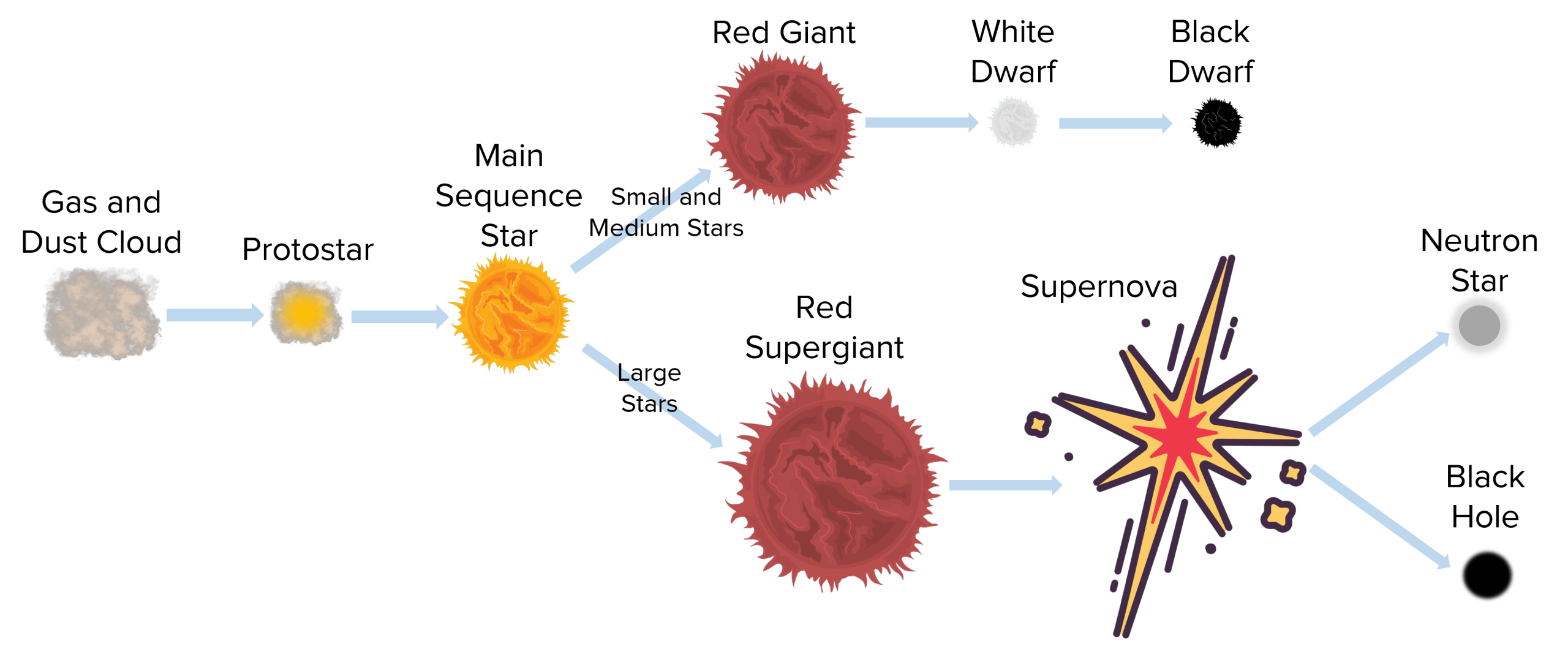Life Cycle of a Star
Life Cycle of a Star Revision
Life Cycle of a Star
Stars have a life-cycle. The Sun is a main sequence star which means it is in the middle of its life.
Life Cycle
Stars begin as a cloud of gas and dust, brought together by gravity. This cloud is called a nebula.
Gravity causes the dust cloud to become more hot and more dense. It has now become a protostar. Eventually, the temperature and pressure become high enough that hydrogen nuclei undergo fusion and become helium nuclei. The fusion reactions release large amounts of energy to keep the core of the star hot.
The protostar then becomes a main sequence star. In main sequence stars, the outward pressure caused by the fusion reaction is balanced with the gravitational force caused by the mass of the star. Stars usually remain in the main sequence for several billion years.
A star leaves the main sequence when the hydrogen starts to run out. What happens next depends on the mass of the star:
- If the star is the size of the Sun or less, it becomes unstable and expands, forming a red giant. The star then ejects its outer layers and becomes a white dwarf, which is the small, hot core of the star. Finally the white dwarf cools into a black dwarf.
- If the star is much bigger than the Sun, it becomes a red supergiant. Supergiants expand and become more hot as fusion occurs in heavier elements, creating elements up to iron. The supergiant eventually becomes so big that it collapses in on itself as a supernova. This is a massive explosion in which fusion occurs and heavier elements than iron are formed. The explosion ejects the outer layers of the star into space. What remains is a dense core called neutron star, or if the supergiant was large enough, a black hole will be formed.
A black hole is an extremely dense point in space, that has such a strong gravitational field, that not even light can escape from it.

The Formation of Elements
In main sequence stars, hydrogen undergoes fusion to create helium only.
In red giants and red supergiants, the higher temperatures and pressures mean that helium undergoes fusion to create heavier elements and these undergo fusion and so on. This occurs until iron is created, as the temperature is not high enough to fuse together iron nuclei.
In supernovae, temperatures and pressures are even greater and so iron and heavier elements undergo fusion. This is the only process in which heavier elements can be formed and therefore all elements in the universe that are heavier than iron (including here on Earth) were made in a supernova.
Life Cycle of a Star Example Questions
Question 1: Which type of force pulls gas and dust together to create a nebula?
[1 mark]
Gravity
Question 2: Describe how a nebula turns into a main sequence star.
[3 marks]
The nebula is compressed by gravity and becomes more hot and dense. It becomes a protostar.
Eventually, the gas and dust become so hot and dense that hydrogen undergoes fusion. It becomes a main sequence star.
Question 3: Explain why the outwards pressure from a main sequence star does not cause the star to explode?
[2 marks]
There is a gravitational force caused by the mass of the star.
This force balances out the outwards pressure.
Question 4: Describe what happens to a main sequence star much bigger than the Sun after it runs out of hydrogen.
[6 marks]
The star expands and becomes hotter and heavier nuclei undergo fusion.
The star becomes a red supergiant.
Eventually, the star becomes so big that it collapses in on itself in a massive explosion called a supernova.
The explosion ejects the outer layers of the star into space.
For smaller supergiants, what remains is a dense core called a neutron star.
If the red supergiant was large enough, a black hole will be formed.


